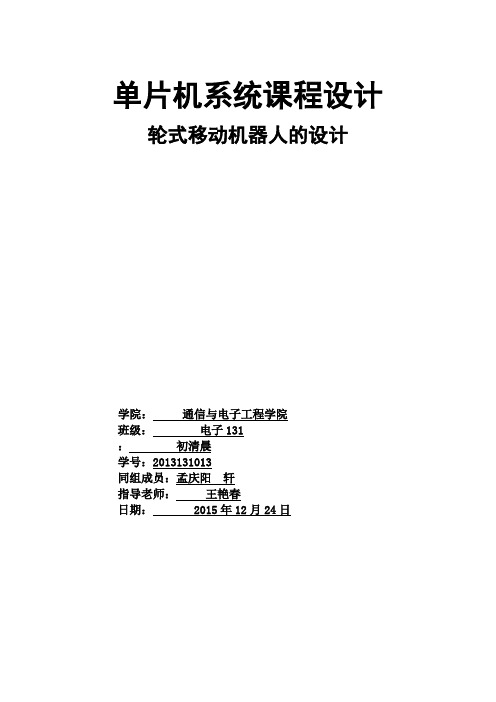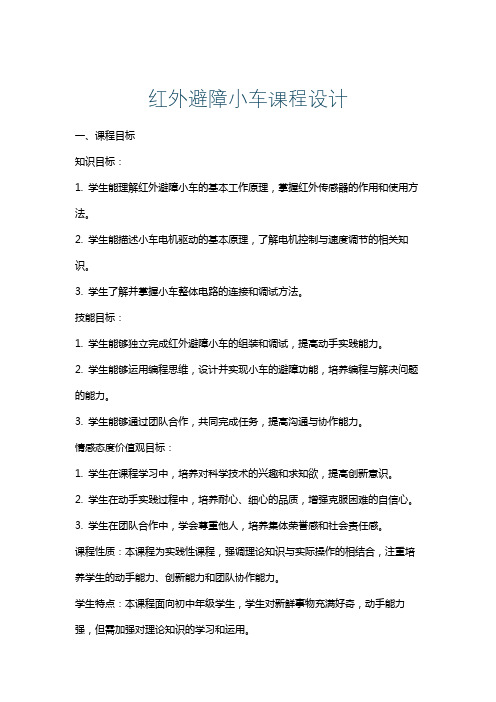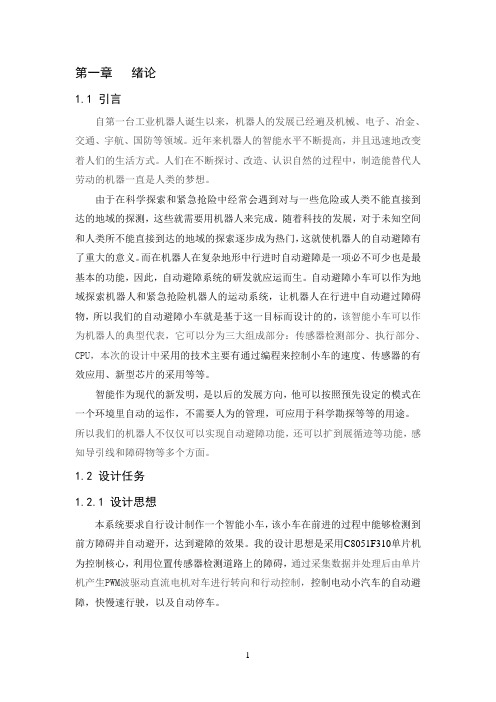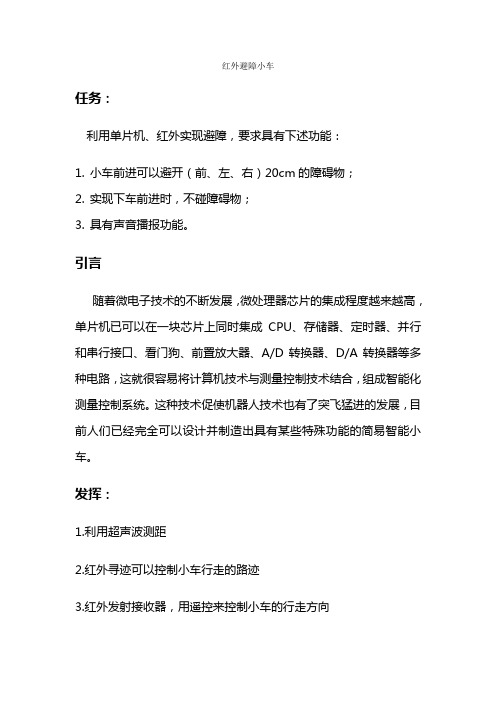毕业设计红外线避障小车的设计
红外线小车避障实训报告

一、实训目的本次实训旨在让学生了解红外线避障技术的原理,掌握红外线避障小车的制作方法,培养学生的动手能力、实践能力和创新精神。
二、实训内容1. 红外线避障原理红外线避障技术是利用红外线发射器和接收器检测前方障碍物,并根据距离调整小车行驶速度和方向的技术。
当红外线发射器发出的红外线遇到障碍物时,部分红外线会被反射回来,被接收器接收,从而实现避障功能。
2. 红外线避障小车制作(1)材料与工具材料:红外线发射器、红外线接收器、STC89C52单片机、电机驱动模块、电源模块、车轮、支架等。
工具:万用表、焊接工具、电烙铁、线路板等。
(2)制作步骤① 设计电路图:根据红外线避障原理,设计电路图,确定各元器件的连接方式。
② 制作线路板:根据电路图,制作线路板,并进行元器件焊接。
③ 安装元器件:将红外线发射器、接收器、单片机、电机驱动模块等元器件安装在车体上。
④ 编写程序:编写单片机程序,实现红外线避障功能。
⑤ 调试与测试:调试程序,测试小车避障效果。
三、实训过程1. 学习红外线避障原理,了解红外线发射器和接收器的工作原理。
2. 根据红外线避障原理,设计电路图,确定元器件连接方式。
3. 制作线路板,进行元器件焊接。
4. 编写单片机程序,实现红外线避障功能。
5. 调试程序,测试小车避障效果。
四、实训结果与分析1. 实训结果通过本次实训,成功制作了一台红外线避障小车,小车能够根据前方障碍物的距离调整行驶速度和方向,实现避障功能。
2. 分析(1)红外线避障原理:红外线避障技术利用红外线发射器和接收器检测前方障碍物,当红外线遇到障碍物时,部分红外线会被反射回来,被接收器接收,从而实现避障功能。
(2)电路设计:电路设计合理,元器件连接正确,程序编写正确,实现了红外线避障功能。
(3)程序调试:程序调试过程中,发现问题并及时解决,提高了小车避障效果。
五、实训总结1. 通过本次实训,使学生掌握了红外线避障技术的原理和制作方法。
基于单片机的红外避障小车本科毕业设计(论文)

□ 优 □ 良 □ 中 □ 及格 □ 不及格
评定成绩:□优□良□中□及格□不及格
教研室主任(或答辩小组组长):(签名)
年 月 日
教学系意见:
系主任:(签名)
年 月 日
摘要
随着科学技术的进步,智能化和自动化技术越来越普及,各种高科技技术也广泛应用于智能小车河机器人玩具制造领域,使智能机器人越来越多样化。智能小车是一个多种高新技术的集成体,融合了机械,计算机硬件,软件,电子,人工智能等多种科学技术的知识,可以涉及到当今许多前言领域的技术。
2、是否完成指定的论文(设计)任务(包括装订及附件)?
□ 优 □ 良 □ 中 □ 及格 □ 不及格
二、论文(设计)水平
1、论文(设计)的理论意义或对解决实际问题的指导意义
□ 优 □ 良 □ 中 □ 及格 □ 不及格
2、论文的观念是否有新意?设计是否有创意?
□ 优 □ 良 □ 中 □ 及格 □ 不及格
This design is mainly composed of single-chip microcomputer control system module, motor drive module, the infrared obstacle avoidance module, voice control module, system with STC89C52RC single-chip microcomputer as the core, through the obstacle avoidance module and voice control module receives information to control the motor running. System by 7 1.5 V dry cell by step-down circuit down into a stable dc 5 V for single chip microcomputer and engine power. This paper introduces the principle of infrared obstacle avoidance, the introduction of overall system design and related software. Software part adopts the modular design thinking, the process includes the main program, motor driver, signal detection procedures, through the car runs the operation of the detected information call to turn left, go straight, or stop function to control the car.
毕业设计论文-红外线控制电动小车

毕业设计论文-红外线控制电动小车1 引言1.1 研究背景与意义随着现代电子技术和自动化技术的飞速发展,红外线遥控技术因其操作简便、抗干扰能力强、低功耗等特点在众多领域得到了广泛应用。
电动小车作为现代交通工具的一种,其控制系统的智能化、远程化成为研究热点。
红外线控制电动小车将红外线遥控技术与电动小车相结合,使得小车操作更为便捷,控制更为精确,尤其在特殊环境下,如危险区域的远程探测和物品搬运,具有显著的应用价值。
1.2 研究目的与内容本文旨在设计并实现一种基于红外线控制的电动小车。
研究内容包括:红外线控制技术的原理及其在电动小车上的应用;电动小车的硬件设计,主要包括电动机选型与驱动、电源与控制系统设计;电动小车的软件设计,包括红外线接收与解码、速度与方向控制算法等。
1.3 研究方法与论文结构本研究采用理论与实验相结合的方法,首先对红外线控制技术进行概述,分析电动小车的结构与功能需求,进而设计并实现相应的硬件和软件系统。
论文结构如下:第二章介绍红外线控制技术的基本原理及发展应用;第三章详细阐述电动小车的硬件与软件设计;第四章进行系统测试与分析;第五章对论文研究进行总结,指出不足,并对未来发展进行展望。
2. 红外线控制技术概述2.1 红外线基本原理红外线是一种电磁波,位于可见光与微波之间,波长范围约为700纳米到1毫米。
红外线的发现归功于天文学家威廉·赫歇尔在19世纪早期的实验。
红外线具有热效应,能够被许多物体吸收并转化为热能,这一特性使其在通信和控制技术中得到了广泛应用。
红外线遥控技术基于红外线的传输特性,通过发射和接收红外线信号来实现远距离控制。
其基本原理是利用红外发射二极管发射调制后的红外信号,经过空气传播后,由红外接收器接收并解调,最终将信号传送到控制电路进行处理。
2.2 红外线遥控技术的发展与应用红外线遥控技术自20世纪60年代问世以来,已广泛应用于家电遥控、工业控制、智能家居等领域。
红外避障机器人毕业设计

摘要随着红外物理与技术的不断发展, 红外探测技术已广泛地应用于军事、煤矿的安全生产等各个领域。
把目标或目标区域的红外辐射聚焦在探测器上红外接收光学系统的基本作用, 通常情况下其结构类似于普通的接收光学系统, 但由于工作波段为红外波段, 其光学材料和镀膜必须和它的工作波长相匹配。
针对题目的要求,我们设计了一款简易的红外避障小车。
电路设计主要有以下四个模块:传感器模块(红外发射和接收器),控制模块(AT89S52),执行模块(伺服电机),电源模块。
传感器模块主要通过对左、右红外传感器的信号分别进行采集,传送给控制模块。
控制模块对采集来的信号进行处理,做出比较后把控制信号传送给执行模块。
配合正确的软件设计,小车能够在设计的赛道中准确快速地完成行走任务。
关键词:红外;避障;传感器AbstractAll bodies has its own infrared radiation characteristics. For studying the various objects of infrared radiation, people use ideal ─absolute blackbody radiation body (hereinafter referred to as in bold) the benchmark. Can absorb all the incident radiation and not the reflection of the object is called in bold. Good absorber must have also been good radiation body, so the blackbody radiation efficiency is highest, the radiation rate than a 1. Any real objects of radiation emission quantity and the same temperature blackbody emission of quantity of launch than, called the object than radiation rate, its value is always less than 1. The object than radiation rate, and the material object types, characteristics, temperature, surface other factors, such as the wavelength.According to the topic request, we design a simple infrared obstacle avoidance of the car. The circuit design basically has the following four modules: sensor module (infrared transmitter and receiver), control module (AT89S52 devices), executive module (servo motor), power supply module. Sensor module mainly through to the left and right of the infrared sensor signal,respectively the collection, transfer to the control module. Control module to the acquisition of signal processing, make more the control after signals to execute module. The software design includes basic car to walk, walk, the combination of infrared obstacle avoidance program design, such as walking strategy improvement, through to the infrared signal processing to achieve the best car walk path.Cooperate with the right software design, the car can in the design of the track accurately and rapidly finish walking task.Keywords: infrared; Obstacle avoidance; sensor目录第一章绪论 (1)1.1红外线研究背景 (1)第二章红外避障机器人的设计方案 (3)2.1主要设计任务 (3)2.2任务分析与方案设计 (3)2.2.1 任务分析 (3)2.2.2 方案设计 (3)第三章硬件电路设计 (5)3.1红外传感器电路设计 (5)3.1.1红外发射二极管的选择 (5)3.1.2红外接收器的选择 (7)3.2控制电路设计 (10)3.3人机接口单元 (11)3.3.1 LCD1602显示 (11)3.3.2串口电路设计 (12)3.4执行电路设计 (13)3.4.1 伺服电机 (13)3.4.2 伺服电机的信号控制 (14)3.5电源电路设计 (14)3.6赛道设计 (15)第四章软件设计 (16)4.1机器人基本行走命令 (16)4.1.1基本巡航动作 (16)4.1.2匀加速/减速运动 (17)4.2红外探测 (19)4.2.1测试红外发射探测器 (19)4.2.2红外发射程序 (20)4.3关于行走赛道的硬件调试与改进 (22)第五章结束语 (23)5.1结论和展望 (23)致谢 (24)第一章绪论1.1 红外线研究背景在科学探索和紧急抢险中经常会遇到对与一些危险或人类不能直接到达的地域的探测,这些就需要用机器人来完成。
毕业设计+智能循迹避障小车设计说明

单片机系统课程设计轮式移动机器人的设计学院:通信与电子工程学院班级:电子131:初清晨学号:2013131013同组成员:孟庆阳轩指导老师:王艳春日期: 2015年12月24日组员分工1、组长:轩,实物焊接,报告整理,程序设计2、组员:孟庆阳,实物焊接,仿真测试,报告整理3、组员:初清晨,实物焊接,报告整理,仿真测试目录摘要0第一章绪论11.1智能小车的意义和作用 (1)1.2智能小车的现状 (2)第二章方案设计与论证22.1 主控系统 (2)2.2 电机驱动模块 (3)2.3 循迹模块 (4)2.4 避障模块 (5)2.5 机械系统 (6)2.6电源模块 (6)第三章硬件设计63.1 AT89S52单片机的简介 (7)3.2总体设计 (10)3.3驱动电路 (11)3.4信号检测模块 (12)3.5主控电路 (13)第四章软件设计134.1主程序框图 (13)4.2电机驱动程序 (14)4.3循迹模块 (15)4.4避障模块 (18)结束语23致23附录一循迹加红外避障综合程序25附录二实物图29摘要随着计算机、微电子、信息技术的快速进步,智能化技术的开发速度越来越快,智能度越来越高,应用围也得到了极大的扩展。
智能作为现代的新发明,是以后的发展方向,它可以按照预先设定的模式在一个环境里自动的运作,不需要人为的管理,可应用于科学勘探等用途。
智能电动小车就是其中的一个体现。
设计者可以通过软件编程实现它的行进、循迹、停止的精确控制以与检测数据的存储、显示,无需人工干预。
因此,智能电动小车具有再编程的特性,是机器人的一种。
本设计采用AT89S52单片机加电机驱动电路和红外遥控与循迹模块还有红外接收一体化传感器设计而成,采用模块化的设计方案,运用红外遥控器控制小车的前进、后退、左转、右转、启动和停止。
关键词:智能小车;STC89C52单片机;L9110;红外对管Intelligent tracking and obstacle-avoid carAbstract:Based infrared detection of black lines and theroad obstacles, and use a STC89C52 MCU as the controlling core for the speed and direction, A electronic drived, which can automatic track and avoid the obstacle, was designed and fabricated. In which, the car is drived by the L298N circuit, its speed is controlled by the output PWM signal from the STC89C52.Keywords: Smart Car; STC89C52 MCU; L298N;Infrared Emitting Diode第一章绪论1.1智能小车的意义和作用自第一台工业机器人诞生以来,机器人的发展已经遍与机械、电子、冶金、交通、宇航、国防等领域。
避障小车毕业论文

避障小车毕业论文避障小车的研究与设计摘要避障小车是一种可以自主避开障碍物的智能小车,其具有重要的应用价值。
本文从机器人控制原理、图像处理技术以及硬件设计等方面出发,对避障小车的设计及其实现方法进行了详细论述。
在硬件设计方面,本文采用了单片机控制器进行控制,采用了基于超声波和红外线的避障传感器,以及直流电机进行驱动。
在软件系统设计方面,本文采用了C语言进行编写,针对避障小车实现了避障、控制、传感器数据处理等功能。
通过实验验证,本文的避障小车能够比较准确地避开障碍物,具有一定的实用价值。
关键词:机器人控制原理、图像处理、硬件设计、软件设计、避障小车AbstractThe obstacle-avoiding robot car is an intelligent car that can autonomously avoid obstacles, with significant application value. This paper elaborates on the design and implementation methods of the obstacle-avoiding small car from the aspects of robot control principle, image processing technology, and hardware design. Interms of hardware design, this paper uses a single-chip microcontroller for control, obstacle-avoiding sensors based on ultrasonic and infrared, and DC motors for driving. In the software system design aspect, this paper uses C language for writing, and realizes the functions of obstacle avoidance, control, and sensor data processing for the obstacle-avoiding small car. Through experiments, the obstacle-avoiding small car in this paper can accurately avoid obstacles and has practical value.Keywords: robot control principle, image processing, hardware design, software design, obstacle-avoiding car引言随着人工智能的发展,智能小车在日常生活和工业环境中得到了广泛的应用。
基于单片机的红外遥控智能小车毕业设计报告

毕业设计(论文)题目:基于单片机的红外遥控智能小车西安邮电学院毕业设计(论文)任务书学生姓名指导教师职称工程师学院电子工程学院系部光电子技术专业光电信息工程题目基于单片机的红外遥控智能小车任务与要求任务:以51单片机为控制核心,实现具有自动避障、加速、减速等功能的红外遥控智能小车。
要求:1 搜集资料,熟悉单片机开发流程;熟悉红外传感器等相关器件;掌握单片机接口和外围电路应用;具备一定的单片机开发经验。
2 学会电路设计、仿真等相关软件的使用;3 具备一定的硬件调试技能。
4 学会查阅资料;5 学会撰写科技论文。
开始日期2010年3月22日完成日期2010年6月27日主管院长(签字) 年月日西安邮电学院毕业设计 (论文) 工作计划学生姓名赵美英指导教师崔利平职称工程师学院电子工程学院系部光电子技术专业光电信息工程题目基于单片机的红外遥控智能小车工作进程主要参考书目(资料)1、何立民,单片机应用系统设计,北京:航天航空大学出版社;2、李广弟,单片机基础,北京:北京航空航天大学出版社,2001;3、何立民,MCS-51系列单片机应用系统设计系统配置与接口技术,北京航空航天大学出版社,1990.01;4、赵负图,传感器集成电路手册,第一版,化学工业出版社,2004;5、Atmel.AT89S51数据手册.主要仪器设备及材料1.普通计算机一台,单片机开发环境;2.电路安装与调试用相关仪器和工具。
(如示波器、万用表、电烙铁、镊子、钳子等)。
论文(设计)过程中教师的指导安排每周四进行交流与总结;其余时间灵活安排,及时解决学生问题。
对计划的说明依学生实际情况,适当调整工作进度。
西安邮电学院毕业设计(论文)开题报告电子工程学院光电子技术系(部)光电信息工程专业2006 级光电0601班课题名称:基于单片机的红外遥控智能小车学生姓名:赵美英学号:05064028指导教师:崔利平报告日期: 2010年3月25日说明:本报告必须由承担毕业论文(设计)课题任务的学生在毕业论文(设计) 正式开始的第1周周五之前独立撰写完成,并交指导教师审阅。
基于单片机的红外避障小车毕业设计(论文) 精品

驾驶员本身的状态信息,必要时发出预警信息。主要包括碰撞预警系统和驾驶员状态监控系统。碰撞预警系统可以给出前方碰撞警告、盲点警告、车道偏离警告、换道/并道警告、十字路口警告、行人检测与警告、后方碰撞警告等.驾驶员状态监控系统包括驾驶员打吨警告系统、驾驶员位置占有状态监测系统等。
本设计主要由单片机控制系统模块、电机驱动模块、红外避障模块、声控模块组成,系统以STC89C52RC单片机为核心,通过避障模块和声控模块接受到的信息来控制电机运行。系统通过7节1.5V干电池通过降压电路降成5V稳定直流电对单片机和发动机进行供电。本文介绍了红外避障的原理、系统整体设计及相关软件的介绍。软件部分采用模块化设计思路,整个程序包括主程序,电机驱动程序,信号检测程序,通过小车运行时检测到的运行信息来调用左转、直行或停止函数来控制小车。
其实物图和原理图如下图
红外传感器E18-D80NK-N实物图
红外传感器E18-D80NK-N内部原理图
电器特性:
红色:VCC;黑色:GND;黄色:OUT。
U:5VDC
This design is mainly composed of single-chip microcomputer control system module, motor drive module, the infrared obstacle avoidance module, voice control module, system with STC89C52RC single-chip microcomputer as the core, through the obstacle avoidance module and voice control module receives information to control the motor running. System by 7 1.5 V dry cell by step-down circuit down into a stable dc 5 V for single chip microcomputer and engine power. This paper introduces the principle of infrared obstacle avoidance, the introduction of overall system design and related software. Software part adopts the modular design thinking, the process includes the main program, motor driver, signal detection procedures, through the car runs the operation of the detected information call to turn left, go straight, or stop function to control the car.
红外避障小车课程设计

红外避障小车课程设计一、课程目标知识目标:1. 学生能理解红外避障小车的基本工作原理,掌握红外传感器的作用和使用方法。
2. 学生能描述小车电机驱动的基本原理,了解电机控制与速度调节的相关知识。
3. 学生了解并掌握小车整体电路的连接和调试方法。
技能目标:1. 学生能够独立完成红外避障小车的组装和调试,提高动手实践能力。
2. 学生能够运用编程思维,设计并实现小车的避障功能,培养编程与解决问题的能力。
3. 学生能够通过团队合作,共同完成任务,提高沟通与协作能力。
情感态度价值观目标:1. 学生在课程学习中,培养对科学技术的兴趣和求知欲,提高创新意识。
2. 学生在动手实践过程中,培养耐心、细心的品质,增强克服困难的自信心。
3. 学生在团队合作中,学会尊重他人,培养集体荣誉感和社会责任感。
课程性质:本课程为实践性课程,强调理论知识与实际操作的相结合,注重培养学生的动手能力、创新能力和团队协作能力。
学生特点:本课程面向初中年级学生,学生对新鲜事物充满好奇,动手能力强,但需加强对理论知识的学习和运用。
教学要求:结合学生特点,教师应采用启发式教学,引导学生主动探究,注重培养学生的自主学习能力和解决问题的能力。
在教学过程中,关注学生的个体差异,提供个性化的指导和支持。
通过课程学习,使学生能够达到上述设定的课程目标,实现知识、技能和情感态度价值观的全面发展。
二、教学内容1. 红外传感器原理与应用:讲解红外传感器的工作原理,引导学生学习传感器在避障小车中的作用,结合教材相关章节,分析传感器电路连接及调试方法。
2. 电机驱动原理:介绍小车电机驱动的基本原理,包括电机的工作原理、控制方法及速度调节,结合教材内容,让学生了解并掌握电机驱动电路的设计与连接。
3. 小车组装与调试:指导学生根据教材相关章节,进行红外避障小车的组装,学习电路连接、传感器安装、电机驱动等步骤,并进行调试。
4. 编程与避障功能实现:教授编程基础知识,引导学生设计并实现小车的避障功能,结合教材内容,让学生掌握编程思维和解决问题的方法。
基于单片机的智能小车设计(红外避障及循迹)

轮式移动机器人的设计报告单片机系统课程设计智能小车(避障及循迹)的设计毕业设计(论文)原创性声明和使用授权说明原创性声明本人郑重承诺:所呈交的毕业设计(论文),是我个人在指导教师的指导下进行的研究工作及取得的成果。
尽我所知,除文中特别加以标注和致谢的地方外,不包含其他人或组织已经发表或公布过的研究成果,也不包含我为获得及其它教育机构的学位或学历而使用过的材料。
对本研究提供过帮助和做出过贡献的个人或集体,均已在文中作了明确的说明并表示了谢意。
作者签名:日期:指导教师签名:日期:使用授权说明本人完全了解大学关于收集、保存、使用毕业设计(论文)的规定,即:按照学校要求提交毕业设计(论文)的印刷本和电子版本;学校有权保存毕业设计(论文)的印刷本和电子版,并提供目录检索与阅览服务;学校可以采用影印、缩印、数字化或其它复制手段保存论文;在不以赢利为目的前提下,学校可以公布论文的部分或全部内容。
作者签名:日期:学位论文原创性声明本人郑重声明:所呈交的论文是本人在导师的指导下独立进行研究所取得的研究成果。
除了文中特别加以标注引用的内容外,本论文不包含任何其他个人或集体已经发表或撰写的成果作品。
对本文的研究做出重要贡献的个人和集体,均已在文中以明确方式标明。
本人完全意识到本声明的法律后果由本人承担。
作者签名:日期:年月日学位论文版权使用授权书本学位论文作者完全了解学校有关保留、使用学位论文的规定,同意学校保留并向国家有关部门或机构送交论文的复印件和电子版,允许论文被查阅和借阅。
本人授权大学可以将本学位论文的全部或部分内容编入有关数据库进行检索,可以采用影印、缩印或扫描等复制手段保存和汇编本学位论文。
涉密论文按学校规定处理。
作者签名:日期:年月日导师签名:日期:年月日注意事项1.设计(论文)的内容包括:1)封面(按教务处制定的标准封面格式制作)2)原创性声明3)中文摘要(300字左右)、关键词4)外文摘要、关键词5)目次页(附件不统一编入)6)论文主体部分:引言(或绪论)、正文、结论7)参考文献8)致谢9)附录(对论文支持必要时)2.论文字数要求:理工类设计(论文)正文字数不少于1万字(不包括图纸、程序清单等),文科类论文正文字数不少于1.2万字。
红外线智能避障小汽车讲解

共 21 页
第 4页
唐山工业职业技术学院毕业设计说明书
片机的中断了。在中断程序中来实现对障碍物的判断和控制小汽车的行驶方向。
§5 H 桥驱动电路
H桥驱动电路是小汽车的“双足”控制电路,对小汽车的行驶有着直接的影 响。如图 2.5.1 所示, 整个车体的驱动用两个 H 桥驱动电路, 分别驱动两个直流 电机,其控制口分别接单片机的 I/O 口,在此接在了 P1 口。在控制其行驶时, 在 P1.4 为低电平的前提下,只要给 P1.0 、P1.1、 P1.2 和 P1.3 输出不同的高低 电平就能控制小汽车的行驶, 但是一定要注意的是, 其中 P1.0 和 P1.1 的电平一 定不能全为高电平, P1.2 和 P1.3 的电平也一定不能全为高电平。现以 P1.0 和 P1.1 如果全为高为例介绍其原理。
共 21 页
第 2页
唐山工业职业技术学院毕业设计说明书
图 2.4.2 红外线发射电路 a). 38K 载波 b). 250HZ 调制信号
c). 调制后波形 图 2.4.3 红外线发射波形图 2、红外线接收部分 红外线接收电路如图 2.4.4 所示,红外线接收头在没有接收到红外信号时, INT0 输出高电平,单片机不中断。在接收到信号时输出低电平,单片机中断。 接收头采用 HS0038A2型一体化接收探头,其内部集成了输入部分、自动增益控 制部分、控制电路、带通滤波器和解调电路。其内部框图如 2.4.5 所示
因为整个系统没有设置看门狗系统,所以在系统死机后需要人工复位,考 虑到复位时各 I/O 口输出全为高电平, 为了防止整个系统死机后复位时输出全高 电平损坏整个系统,所以在电源和整个电路之间加一 PNP型三极管 Q13,其基极 接 P1.4 ,当单片机复位时 P1.4 输出高电平, Q13截止,整个电路不供电,保证 了电路的安全性能。 H桥控制原理图如图 2.5.1 所示:
论文-红外避障小车

第一章绪论1.1 引言自第一台工业机器人诞生以来,机器人的发展已经遍及机械、电子、冶金、交通、宇航、国防等领域。
近年来机器人的智能水平不断提高,并且迅速地改变着人们的生活方式。
人们在不断探讨、改造、认识自然的过程中,制造能替代人劳动的机器一直是人类的梦想。
由于在科学探索和紧急抢险中经常会遇到对与一些危险或人类不能直接到达的地域的探测,这些就需要用机器人来完成。
随着科技的发展,对于未知空间和人类所不能直接到达的地域的探索逐步成为热门,这就使机器人的自动避障有了重大的意义。
而在机器人在复杂地形中行进时自动避障是一项必不可少也是最基本的功能,因此,自动避障系统的研发就应运而生。
自动避障小车可以作为地域探索机器人和紧急抢险机器人的运动系统,让机器人在行进中自动避过障碍物,所以我们的自动避障小车就是基于这一目标而设计的的,该智能小车可以作为机器人的典型代表,它可以分为三大组成部分:传感器检测部分、执行部分、CPU,本次的设计中采用的技术主要有通过编程来控制小车的速度、传感器的有效应用、新型芯片的采用等等。
智能作为现代的新发明,是以后的发展方向,他可以按照预先设定的模式在一个环境里自动的运作,不需要人为的管理,可应用于科学勘探等等的用途。
所以我们的机器人不仅仅可以实现自动避障功能,还可以扩到展循迹等功能,感知导引线和障碍物等多个方面。
1.2 设计任务1.2.1 设计思想本系统要求自行设计制作一个智能小车,该小车在前进的过程中能够检测到前方障碍并自动避开,达到避障的效果。
我的设计思想是采用C8051F310单片机为控制核心,利用位置传感器检测道路上的障碍,通过采集数据并处理后由单片机产生PWM波驱动直流电机对车进行转向和行动控制,控制电动小汽车的自动避障,快慢速行驶,以及自动停车。
1.2.2 功能概述根据题目中的设计要求,本系统主要由微控制器模块、避障模块、直流电机及其驱动模块电源模块等构成。
本系统的方框图如图1-2-2所示:图1-1 系统方框图微控制器模块:通过采用C8051F310作为微控制器接受传感器部分收集到的外部信息进行处理,并将结果输出到电机驱动模块控制电机运行。
智能小车红外线避障电路设计

经验交流Digital Space P .137项目教学法,对于教师而言,其是要通过对学生进行针对性的指导,积极有效地转变教育观念和教学方式,转变自己的身份,从最开始简单的知识传递者转变成为学生学习的组织者、指导者以及促进者。
2.3具有较好的可控性项目教学法的实施需要教师和学生的共同参与,学生在此教学方法中所完成的各种活动和任务都必须要由教师进行全程指导的,这对于培养和提高学生集中精力练习技能有着非常大的帮助。
2.4其追求理论和实践的高效结合要想完成好这一个项目,其中必然会涉及到两个主要方面的内容,一是理论,二是实践。
这就要求学生们必须要从最基本的原理着手学习和了解,结合更多针对性的原理分析项目和订制工艺。
3学前教育信息技术课程中项目学习的实际应用分析3.1实施分工协作在学前教育信息技术课程教学中,信息技术教师会以不同学生的学习需求作为开展项目学习的重要标准,坚持一切从实际出发的原则,提前做好学生的分层准备工作,确保每一名学生都能够在项目学习方法中学习到有价值的知识。
信息技术在开展项目教学时,通常会以小组合作的方式来进行项目活动,实施分工协作,每一名学生都会被分配到适合自己的任务,然后通过小组合作的方式来共同完成好教师分配的全部任务。
在这里笔者需要提醒一点内容,教师在安排任务时,必须要充分考虑到每一名学生的特点和学习需求,一定要根据学生的实际兴趣爱好以及实际能力合理安排任务,对项目活动进行精心设计,一定要对小组成员之间的分工与各自的职责进行全面考虑。
3.2明确目标,以目标激发学生的学习兴趣在实际教学过程中,运用项目教学法,信息技术教师需要将亟待解决的问题或者需要共同完成的任务通过项目的形式分配到每一名学生身上。
通过小组合作的方式,根据教师提出的任务或者问题,一起参与讨论,最终确定清楚项目的最终任务和目标。
笔者建议,在这一环节,信息技术教师可以采取直接引入情景的方式,借助合适的方式将学生们都吸引到共同的情景当中来,让学生们都能够对具体项目产生比较直观的认知,与此同时,学生被引入到具体情景之后,也能够在一定程度上激发起学生的学习兴趣和学习热情。
单片机课程设计-红外避障小车模板

红外避障小车任务:利用单片机、红外实现避障,要求具有下述功能:1.小车前进可以避开(前、左、右)20cm的障碍物;2.实现下车前进时,不碰障碍物;3.具有声音播报功能。
引言随着微电子技术的不断发展,微处理器芯片的集成程度越来越高,单片机已可以在一块芯片上同时集成CPU、存储器、定时器、并行和串行接口、看门狗、前置放大器、A/D转换器、D/A转换器等多种电路,这就很容易将计算机技术与测量控制技术结合,组成智能化测量控制系统。
这种技术促使机器人技术也有了突飞猛进的发展,目前人们已经完全可以设计并制造出具有某些特殊功能的简易智能小车。
发挥:1.利用超声波测距2.红外寻迹可以控制小车行走的路迹3.红外发射接收器,用遥控来控制小车的行走方向工作日程安排:序号毕业设计各阶段的名称日期1 设计单片机外部接线图,以及其它相关电路连接。
09.11.23-09.11.242 设计单片机程序,驱动电路的程序及注解。
09.11.25-09.11.283 编制设计的元件明细表09.11.29-09.11.294 编制电路元件明细表09.11.29-09.11.305 编写操作原理说明09.11.31-09-11.316 编写在实验室进行硬件和软件的调试以及所需的补充资料10.1.1-10.1.37 在创新实验室做模拟调试10.1.4-10.1.68 编写摘要10.1.7-10.1.79 将设计资料装订成册,交给指导教师,准备答辩10.1.10摘要针对题目的要求,我们设计了一款简易的红外避障小车。
该电路设计分别以驱动模块,单片机控制显示模块组成。
为了达到题目的要求,我们以ATMEGA16-L为核心控制器件,以LM298驱动电机控制系统和红外监测系统设计而成。
关键词:ATMEGA16-L;红外避障检测电路;驱动电路。
整体构思:一.模块方案比较1.壁障模块在壁障模块中,可以选择超声波壁障。
其优点是反应速度灵敏,距离远,受外界干扰小。
(新)红外避障小车课程设计报告

前言---------------------------------------------------随着生产自动化的发展需要,机器人已经越来越广泛地应用到生产自动化上,随着科学技术的发展,机器人的传感器种类也越来越多,其中红外传感器已经成为自动行走和驾驶的重要部件。
红外的典型应用领域为自主式智能导航系统,机器人要实现自动避障功能就必须要感知障碍物,感知障碍物相当给机器人一个视觉功能。
智能避障是基于红外传感系统,采用红外传感器实现前方障碍物检测,并判断障碍物远近。
由于时间和水平有限,我们暂选最基本的避障功能作为此次设计的目标。
本设计通过小车这个载体再结合由AT89S51为核心的控制板可以达到其基本功能,再辅加由漫反射式光电开关组成的避障电路、555组成的转速控制电路、电源电路、差分驱动电路就可以完善整个设计。
目录前言------------------------------------------------------------------------------1目录------------------------------------------------------------------------------2摘要------------------------------------------------------------------------------3功能概述------------------------------------------------------------------------3硬件设计------------------------------------------------------------------------3 避障电路------------------------------------------------------------------------4单片机电路---------------------------------------------------------------------7电机转速控制电路------------------------------------------------------------7电源电路------------------------------------------------------------------------8电机驱动电路---------------------------------------------------------------9主程序设计--------------------------------------------------------------------12小结-----------------------------------------------------------------------------23参考文献-----------------------------------------------------------------------231.【摘要】:本文提出一种智能避障小车的设计方法,利用红外技术检测障碍物信息,采用AT89S51单片机进行实时控制,实现智能避障,智能小车采用后轮驱动,两轮各用一个直流电机控制,避障用的传感器采用红外漫反射式传感器。
红外避障机器人毕业设计

红外避障机器人毕业设计As a person, we must have independent thoughts and personality.摘要随着红外物理与技术的不断发展, 红外探测技术已广泛地应用于军事、煤矿的安全生产等各个领域。
把目标或目标区域的红外辐射聚焦在探测器上红外接收光学系统的基本作用, 通常情况下其结构类似于普通的接收光学系统, 但由于工作波段为红外波段, 其光学材料和镀膜必须和它的工作波长相匹配。
针对题目的要求,我们设计了一款简易的红外避障小车。
电路设计主要有以下四个模块:传感器模块(红外发射和接收器),控制模块(AT89S52),执行模块(伺服电机),电源模块。
传感器模块主要通过对左、右红外传感器的信号分别进行采集,传送给控制模块。
控制模块对采集来的信号进行处理,做出比较后把控制信号传送给执行模块。
配合正确的软件设计,小车能够在设计的赛道中准确快速地完成行走任务。
关键词:红外;避障;传感器AbstractAll bodies has its own infrared radiation characteristics. For studying the various objects of infrared radiation, people useideal─absolute blackbody radiation body (hereinafter referred to as in bold) the benchmark. Can absorb all the incident radiation and not the reflection of the object is called in bold. Good absorber must have also been good radiation body, so the blackbody radiation efficiency is highest, the radiation rate than a 1. Any real objects of radiation emission quantity and the same temperature blackbody emission of quantity of launch than, called the object than radiation rate, its value is always less than 1. The object than radiation rate, and the material object types, characteristics, temperature, surface other factors, such as the wavelength.According to the topic request, we design a simple infrared obstacle avoidance of the car. The circuit design basically has the following four modules: sensor module (infrared transmitter and receiver), control module (AT89S52 devices), executive module (servo motor), power supply module. Sensor module mainly through tothe left and right of the infrared sensor signal, respectively the collection, transfer to the control module. Control module to the acquisition of signal processing, make more the control after signals to execute module. The software design includes basic car to walk, walk, the combination of infrared obstacle avoidance program design, such as walking strategy improvement, through to the infrared signal processing to achieve the best car walk path.Cooperate with the right software design, the car can in the design of the track accurately and rapidly finish walking task.Keywords: infrared; Obstacle avoidance; sensor目录第一章绪论.................................. 错误!未定义书签。
arduino红外避障小车课程设计报告

arduino红外避障小车课程设计报告一、设计简介红外避障小车是一款利用红外传感器避开障碍物的智能小车。
通过在车身前方安装红外传感器,当小车遇到障碍物时,传感器能够检测到障碍物并发送信号给控制器,控制器根据接收到的信号调整小车的运动状态,实现自动避障。
二、系统构成1.控制器:采用Arduino控制器,通过编程实现小车的运动控制和红外避障功能。
2.红外传感器:选用光电传感器,能够检测到前方障碍物并发送信号给控制器。
3.电机驱动器:采用L293D或L298N电机驱动器,驱动小车前进、后退、左转和右转。
4.电池:为整个系统提供电源。
三、硬件搭建1.将控制器、红外传感器、电机驱动器和电池按照电路图正确连接。
2.将红外传感器固定在小车前方适当位置,确保能够检测到前方障碍物。
3.将电池固定在小车底部,保证电源供应稳定。
四、软件编程1.导入Arduino开发环境,编写程序实现小车的运动控制和红外避障功能。
2.编写程序控制电机驱动器,实现小车的运动控制。
3.编写程序读取红外传感器的信号,根据传感器信号调整小车的运动状态。
4.调试程序,确保小车能够正常运行并实现红外避障功能。
五、测试与验证1.在不同环境下测试小车的避障功能,包括直线、曲线、障碍物大小和距离等。
2.观察小车的运动状态,检查是否存在异常情况。
3.测试小车的响应速度和稳定性,确保其性能达到预期要求。
4.在实际应用中进行测试,验证小车的实用性和可靠性。
六、总结与展望本设计实现了一款基于Arduino控制器的红外避障小车,通过编程实现了小车的运动控制和避障功能。
测试结果表明,小车的性能稳定可靠,具有较好的实用性和市场前景。
未来可以进一步完善小车的功能,如增加无线遥控、自动导航等,提高其智能化程度和应用范围。
智能避障小车设计毕业论文.doc

智能避障小车设计毕业论文目录1引言 (1)1.1课题背景 (1)1.2论文的研究任务与内容 (2)2方案设计与论证 (3)2.1主控系统 (3)2.2直流调速系统 (4)2.3检测系统 (5)2.4电机驱动系统 (6)2.5 机械系统 (8)2.6电源模块 (9)3硬件设计 (10)3.1总体设计 (10)3.1.189C52单片机硬件结构 (12)3.1.2单片机最小系统设计 (16)3.2避障模块 (18)3.3驱动电路 (19)3.4总控制系统 (23)4软件设计 (24)4.1程序设计 (24)4.1.1电机驱动程序 (24)4.1.2避障程序 (25)4.1.3电机调速程序 (28)5总结与展望 (32)致谢 (33)参考文献 (34)外文资料 (35)附录1程序清单 (40)附录2电路图 (53)1引言1.1课题背景机器人技术的发展,它应该说是一个科学技术发展共同的一个综合性的结果,同时,为社会经济发展产生了一个重大影响的一门科学技术,它的发展归功于在第二次世界大战中各国加强了经济的投入,就加强了本国的经济的发展。
比如说日本,战后以后开始进行汽车的工业,那么这时候由于它人力的缺乏,它迫切需要一种机器人来进行大批量的制造,提高生产效率降低人的劳动强度,这是从社会发展需求本身的一个需求。
另一方面它也是生产力发展的需求的必然结果,也是人类自身发展的必然结果。
但另一方面,尽管人们有各种各样的好的想法,但是它也归功于电子技术,计算机技术以及制造技术等相关技术的发展而产生了提供了强大的技术保证。
机器人经历了三个发展阶段:第一代机器人也叫示教再现型机器人,它是通过一个计算机,来控制一个多自由度的一个机械,通过示教存储程序和信息,工作时把信息读取出来,然后发出指令。
第二代机器人,也被称作带感觉的机器人,这种带感觉的机器人是类似人在某种功能的感觉,比如说力觉、触觉、滑觉、视觉、听觉。
第三代机器人,也是我们机器人学中一个理想的所追求的最高级的阶段,叫智能机器人,那么只要告诉它做什么,不用告诉它怎么去做,它就能完成运动,感知思维和人机通讯的这种功能和机能。
- 1、下载文档前请自行甄别文档内容的完整性,平台不提供额外的编辑、内容补充、找答案等附加服务。
- 2、"仅部分预览"的文档,不可在线预览部分如存在完整性等问题,可反馈申请退款(可完整预览的文档不适用该条件!)。
- 3、如文档侵犯您的权益,请联系客服反馈,我们会尽快为您处理(人工客服工作时间:9:00-18:30)。
摘要随着生产自动化的发展需要,机器人已经越来越广泛地应用到生产自动化上,随着科学技术的发展,机器人的传感器种类也越来越多,其中红外传感器已经成为自动行走和驾驶的重要部件。
红外的典型应用领域为自主式智能导航系统,机器人要实现自动避障功能就必须要感知障碍物,感知障碍物相当给机器人一个视觉功能。
智能避障是基于红外传感系统,采用红外传感器实现前方障碍物检测,并判断障碍物远近。
由于时间和水平有限,我们暂选最基本的避障功能作为此次设计的目标。
本设计通过小车这个载体再结合由AT89S51为核心的控制板可以达到其基本功能,再辅加由漫反射式光电开关组成的避障电路、555组成的转速控制电路、电源电路、差分驱动电路就可以完善整个设计。
关键词:避障光电开关红外线漫反射差分控制Infrared obstacle avoidance carAbstractWith the development needs of the production automation, robots have been more and more widely applied to the automation of production, with the development of science and technology, the robot more and more types of sensors, including infrared sensors has become an important component of the automatic walking and driving .Infrared Typical applications for autonomous intelligent navigation systems, robotics to achieve automatic obstacle avoidance must be perceived obstacles, perceived obstacles to the robot quite a visual function. Intelligent obstacle avoidance system based on infrared sensor, infrared sensor front obstacle detection and determine the obstacle distance.Due to the limited time and the level of our most basic obstacle avoidance temporary as the design goal.Design by car carrier recombination by AT89S51 as the core of the control panel can achieve its basic functions, supplemented plus diffuse photoelectric switch obstacle avoidance circuit 555 comprising a speed control circuit, power circuit, a differential drive circuit. You can improve the entire design.Keywords: obstacle avoidance photoelectric switch infrared diffuse reflectance differential control目录前言 (V)第1章课题研究价值 (VI)第1.1节选题背景 (VI)第2章课题设计 (VII)第2.1节设计要求 (VII)第2.2节总体设计 (VII)第3章方案论证 (IX)第3.1节单片机选择论证 (IX)第3.2节传感器设计方案 (IX)第3.3节控制算法设计方案 (X)第4章智能小车硬件设计 (XII)第4.1节智能小车硬件分配 (XII)第4.2节 AT89S51单片机简介 (XV)第4.3节电路设计 (XVIII)第5章智能小车软件设计 .......................................................... X XIV 第5.1节总体流程图.................................................................. X XIV 第5.2节最少拍控制算法 .......................................................... X XVI第6章开发流程 (XXIX)第6.1节编译环境 (XXIX)第6.2节下载调试 (XXXI)第6.3节单片机的I/O分配 (XXXI)结论 (XXXIII)附录A ................................................................................... X XXIV 附录B .................................................................................. X XXVII 附录C ................................................................................. X XXVIII 参考文献 .......................................................................................... X LII 致谢 ......................................................................................... X LIII前言随着生产自动化的发展需要,机器人已经越来越广泛地应用到生产自动化上,随着科学技术的发展,机器人的传感器种类也越来越多,其中红外传感器已经成为自动行走和驾驶的重要部件。
红外的典型应用领域为自主式智能导航系统,机器人要实现自动避障功能就必须要感知障碍物,感知障碍物相当给机器人一个视觉功能。
智能避障是基于红外传感系统,采用红外传感器实现前方障碍物检测,并判断障碍物远近。
由于时间和水平有限,我们暂选最基本的避障功能作为此次设计的目标。
本设计通过小车这个载体再结合由AT89S51为核心的控制板可以达到其基本功能,再辅加由漫反射式光电开关组成的避障电路、555组成的转速控制电路、电源电路、差分驱动电路就可以完善整个设计。
第1章课题研究价值第1.1节选题背景国内外随着计算机技术,控制技术,信息技术的快速发展,工业的生产和管理进入了自动化,信息化和智能化的时代,智能化已经成为时代发展的需要。
第三代单片机包括了Intel公司发展MCS-51系列的新一代产品,如8xC152﹑80C51FA/FB﹑80C51GA/GB﹑8xC451﹑8xC452,还包括了Philips ﹑Siemens﹑ADM﹑Fujutsu﹑OKI﹑Harria-Metra﹑ATMEL等公司以80C51为核心推出的大量各具特色﹑与80C51兼容的单片机。
新一代的单片机的最主要的技术特点是向外部接口电路扩展,以实现Microcomputer完善的控制功能为己任,将一些外部接口功能单元如A/D﹑PWM﹑PCA(可编程计数器阵列)﹑WDT(监视定时器)﹑高速I/O口﹑计数器的捕获/比较逻辑等。
这一代单片机中,在总线方面最重要的进展是为单片机配置了芯片间的串行总线,为单片机应用系统设计提供了更加灵活的方式。
Philips公司还为这一代单片机80C51系列8xC592单片机引入了具有较强功能的设备间网络系统总线----CAN(Controller Area Network BUS).新一代单片机为外部提供了相当完善的总线结构,为系统的扩展与配置打下了良好的基础。
该项目可以应用于机车头自动寻迹,工厂自动化,仓库管理,可提高劳动生产效率,改善劳动环境。
在柔性自动化生产线,智能仓库管理及物流配送等领域,当生产环境恶劣时,工人不能完成的任务如物料运输和装卸等,可采用智能寻迹小车完成相应的任务。
基于生产现场和日常生活的实际需要,研究和开发智能寻迹小车系统具有十分重要的意义。
第2章课题设计第2.1节设计要求在本次设计中,要求所设计的小车具有自动避障的功能,能在红外探头探测到前方有障碍物的时候先进行后退大约2秒再进行向左转180度角,第二次探测到前方障碍物的时候再后退大约2秒再进行向右转180度角,这样循环下去。
很明显,我要设计的小车是要能遇见障碍物自动窥探到障碍物并立即倒退和转动方向重新行驶,当然小车行驶速度不会有太大的变化。
第2.2节总体设计图2.1 系统框架图说明智能避障小车能避障主要是由前方的两对红外发射与接收探头来完成的。
根据光有反射的特性。
所以说当红外发射出来的光线遇到物体时,就会形成反射的光线,而这个经反射的红外光线刚好被红外接收探头接收到。
当红外接收探头接收到信号后,再将信号送到单片机由单片机内部程序来控制电机,由电机完成小车的前进,转向。
第3章方案论证第3.1节单片机选择论证在单片机选择提供两种选择一种是8031另一种是AT89S51。
选用8031单片机系统8031单片机内不带程序存储器ROM,使用时用户需外接程序存储器8255和一片2764,来进行扩展。
电路复杂。
选用AT89S51单片机系统AT89S51里有4K程序存储器是FLASH工艺的,这种工艺的存储器用户可以用电的方式瞬间擦除、改写。
不用扩展外部存储器。
显而易见,这种单片机对开发设备的要求很低,开发时间也大大缩短。
由此可见选用AT89S51单片机。
第3.2节传感器设计方案在传感器方案的选择中,有以下两种方案供参考:方案一:使用CCD传感器来采集路面信息。
使用CCD传感器,可以获取大量的图像信息,可以全面完整的掌握路径信息,可以进行较远距离的预测和识别图像复杂的路面而且抗干扰能力强。
但是对于本项目来说,使用CCD传感器也有其不足之处。
首先使用CCD传感器需要有大量图像处理的工作,需要进行大量数据的存储和计算。
因为是以实现小车视觉为目的,实现起来工作量较大,电路复杂。
方案二:使用光电传感器来采集路面信息。
